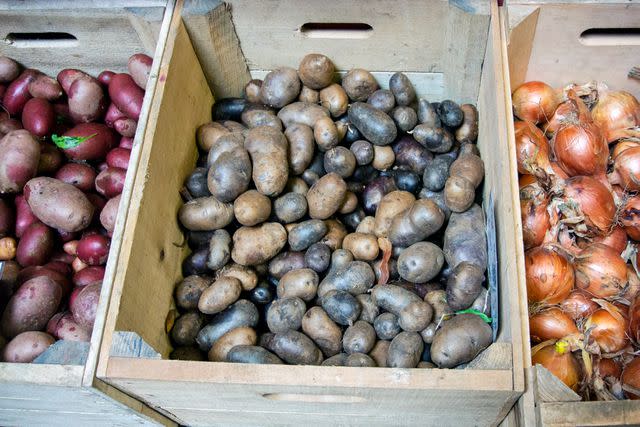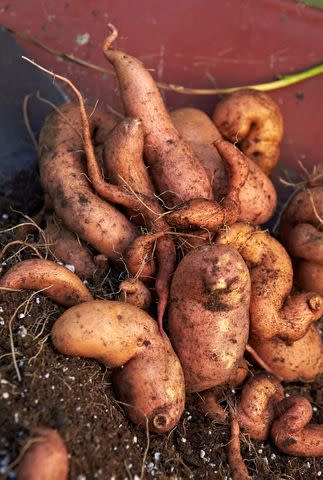What Is a Root Cellar? Plus 7 Tips for Keeping Veggies Fresh in One
Store your vegetables and fruit without electricity with the help of a simple, DIY root cellar.
Canning, pickling, and dehydrating are all handy ways to preserve fresh garden harvests at the end of the growing season. However, if you prefer to keep vegetables whole or you don’t want to tangle with canning equipment, there is another option: using a root cellar.
Many food crops, including apples, potatoes, and rutabagas, can be stored in electricity-free root cellars, freeing up space in your refrigerator and helping you save money on your energy bill. Best of all, root cellars are easy to make and don’t take up much space. If you’re ready to create your own DIY root cellar, here is everything you need to know to store food crops through the winter months.

indigojt / Getty Images
What Is a Root Cellar?
Before the advent of electricity, people relied on root cellars to keep their food fresh throughout the year. Since root cellars are usually built below grade, they are kept cool by the natural insulating properties of the earth. Traditionally, root cellars were built in basements, but root cellars can also be dug outdoors or into hillsides.
Root cellars remain cool in summer but warm enough in winter to keep foods from freezing. Aside from temperature regulation, root cellars keep light levels low and humidity levels high, which extends the shelf life of many homegrown fruits and vegetables.
Advantages of a Root Cellar
Root cellars keep food fresh without any electricity, which can save money on your energy bill. Beyond that, root cellars prevent food waste and provide perfect storage conditions for many types of vegetables and fruit.
Today, most people buy produce at the grocery store, but store-bought produce is often not grown locally and may not be fresh. If you keep a garden, you know how tasty homegrown produce is; a root cellar allows you to enjoy those delicious garden goodies all year round.

Foods to Store in a Root Cellar
Delicate fruit and vegetables, like leafy greens and berries, don’t last long in a root cellar, but sturdy or thick-skinned crops can be kept fresh for months. Root cellars can also be used to store wine and canned or pickled goods. However, most gardeners use root cellars to store a variety of vegetables and fruit, including:
Apples
Pears
Carrots
Turnips
Parsnips
Beets
Rutabagas
Winter radishes
Winter squash
Heading cabbages
Pumpkins
Potatoes
Sweet potatoes
Tips
Some vegetables store longer if they’re cured after harvesting. This process hardens the vegetable’s skin and helps seal any scruffs or scratches that might otherwise let in bacteria. To cure vegetables, place them in a warm, dry place that’s out of direct sunlight and allow them to dry for about two weeks. Crops such as garlic, onions, squash, and potatoes should be cured, while most root crops rarely need curing.
How to Create a DIY Root Cellar
If you own an old home, you may already have a traditional root cellar built into your basement. If not, root cellars can be adapted to newer builds and garden settings.
A few simple shelves added to an unfinished basement can provide plenty of storage space for food, but you can also create a root cellar in an unused closet or other cool place. Basements with packed earth or gravel floors work best for root cellars, but basements with concrete or other flooring types can also be adapted. For even more options, you can dig a root cellar into your garden, but it’s essential to follow safety protocols and get any required building permits before you start digging.
One of the easiest ways to make a small root cellar is to dig a hole in your yard and sink a garbage can or food-safe barrel inside. Fill the barrel with some straw, add your root crops and other veggies, replace the lid, and place a bale of straw on top for extra insulation. This simple, DIY setup can hold many different crops, but it works particularly well for storing root vegetables like carrots, beets, and parsnips.
Related: 12 Things You Should Never Store in the Basement
Food Storage Tips for Root Cellars
1. Monitor the temperature.
Ideally, root cellars should be a chilly 32°F to 40°F, and they should never freeze. Even root cellars that cool only into the 50s protect many vegetables. (In summer, the temperature might reach the 60s in hot areas). Freezing temperatures damage produce, while warm temperatures speed up decay. Because root cellars are built below the soil’s surface, they naturally stay cool, but you may want to invest in a thermometer to ensure your cellar stays in the correct temperature range.
2. Maintain high humidity.
Crops stored in dry environments can become wrinkly and limp due to water loss, but root cellars are naturally humid places with humidity levels above 80 percent. Cellars with gravel or dirt floors naturally maintain higher humidity levels, although you can add a humidifier to boost humidity if your cellar is on the dry side.
Related: The 10 Best Humidifiers for Plants of 2023
3. Block out light.
Light speeds up decay and color loss in produce, and it also causes potatoes to turn green. To avoid this, keep the lights off when you’re not using your root cellar, and add burlap or other drapes over any windows to block excess light. You can also keep potatoes from sprouting by loosely covering them with a piece of burlap.
4. Boost ventilation.
While high humidity keeps veggies plump, too much humidity can promote mold and mildew growth. To avoid this, make sure your root cellar is well-ventilated and consider adding a PVC pipe to small root cellar barrels to boost ventilation. If you store your produce in crates or boxes, ensure that the containers have plenty of ventilation holes to improve airflow.
5. Only store unwashed, undamaged produce.
Excess moisture promotes mold and mildew, so avoid washing produce before placing it in your root cellar. Keep fruit and vegetables in approximately the same condition as they were when they were harvested. Although you should snip away carrot and beet greens, store vegetables as whole as possible, and leave the stems on pumpkins and gourds. Use any damaged produce immediately rather than storing it because it will begin to decay quickly.
Tips
Root vegetables, including beets, carrots, and winter radishes, last longer if you store them in moist sand. The extra moisture keeps the roots from drying out, allowing you to enjoy crunchy carrots all year round. Store root crops horizontally or vertically in sturdy boxes or food-safe plastic buckets.
6. Separate fruits and vegetables.
Apples and pears store beautifully in root cellars, but these crops release ethylene gas, which can cause nearby vegetables to become overly ripe and go bad. Keeping a well-ventilated root cellar reduces ethylene levels, but storing vegetables and fruit separately is still recommended. To be extra safe, wrap apples and pears in newspaper to prevent the ethylene gas from escaping.
7. Keep an eye on your produce.
As the old saying goes, “A bad apple can spoil the bunch,” and that’s undoubtedly true in root cellars. While healthy produce can be kept for months in a root cellar, if a piece of fruit or a vegetable starts to go bad, the rot can quickly spread to nearby crops. To avoid problems, check your food stores regularly and remove any damaged or decayed produce as soon as you spot it.
Related: 6 Secrets to Starting Your First Vegetable Garden Off Right
For more Better Homes & Gardens news, make sure to sign up for our newsletter!
Read the original article on Better Homes & Gardens.

